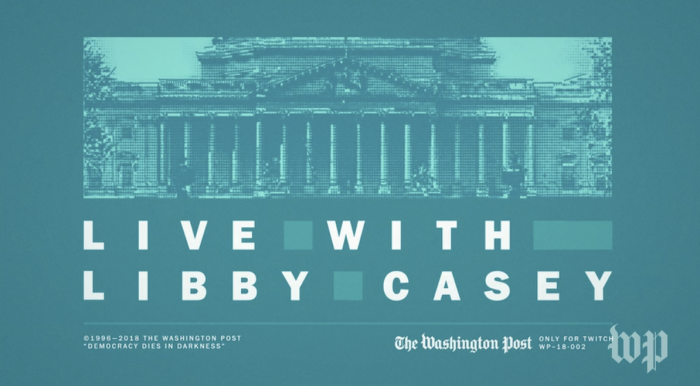
Twitch: It’s not just for Fortnite battle royales anymore. The Washington Post tried out broadcasting on the streaming platform best known for gaming yesterday with content related to politics — which is its own battle royale, really.
The Post’s plans for the platform include “postgame” coverage of major news events hosted by political reporter Libby Casey and a series called Playing Games with Politicians, in which political reporter Dave Weigel will interview politicians while playing video games. On Monday, the Post streamed coverage of Donald Trump’s meeting with Russian president Vladimir Putin.
Twitch — which is owned by Amazon, whose CEO Jeff Bezos owns The Washington Post — can be thought of as a cross between YouTube and a Reddit AMA. Accounts host live video feeds of content (usually video games) and viewers speak to each other in a chat feature. (If anyone’s actually watching.) It has 15 million daily active users and over 2.2 million broadcasters; 81.5 percent of users are male, and 55 percent are between the ages of 18 and 34 — in other words, a hard-to-reach demographic for political news. Video game journalists frequently use Twitch to review games or cover conferences like E3, but political coverage is less common.
The Post has experimented with Twitch before. “Our first streaming experiment on Twitch was for Mark Zuckerberg’s testimony on Capitol Hill,” Phoebe Connelly, the Post’s deputy digital director, said in a press release, “and the real-time conversations and engagement showed us there was interest in news and analysis on the service.”

Twitch is a labor-intensive social platform. It’s popular among e-sports gamers and YouTube personalities who play games as a way to attract new viewers, who might then be inspired to support the content creator on more profitable platforms. But it’s not a big money-maker for most broadcasters. Users can subscribe to a channel to support a streamer for $4.99 per month; ads run during breaks in the feed or before.
Users tend to go to Twitch to hang out with friends rather than to engage in political discussion. But the early response to the Post’s effort to create “a space for civil discourse on issues of the day” has been positive. As many as 1,000 people watched the Post’s coverage of the Trump/Putin meeting on Twitch on Monday. User jeanviper commented, “This s*** was hilarious thanks for the content.” The Post’s channel now has more than 14,000 followers, who receive email notifications as broadcasts begin.

Casey said that she thought the first broadcast “went fabulously…it’s like a version of C-SPAN for a younger audience.”